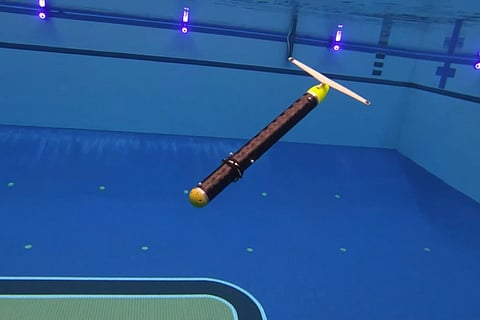

Researchers at Purdue University in the United States have begun development of a fleet of unmanned underwater vehicles (UUVs) that are optimised for survey and research duties in the tighter confines of near-shore environments.
The prototype UUV, named Research-Oriented Underwater Glider for Hands-on Investigative Engineering (ROUGHIE), was designed by a team led by Purdue mechanical engineering associate professor Nina Mahmoudian with grant funding support from the National Science Foundation (NSF), the US Office of Naval Research (ONR), and the US Naval Sea Systems Command's (NAVSEA) Small Business Technology Transfer program. It is being developed as a lower-cost (estimated to be 90 per cent more affordable), more highly manoeuvrable, and quieter alternative to commercially available unmanned gliders.
Mahmoudian said the development of ROUGHIE seeks to overcome issues typically inherent in underwater robots such as limited battery life, which would force them to return to the surface after only a few hours of operation. It was decided that a long-endurance underwater glider that was capable of traveling for weeks or months in between rechargings may also prove practical in areas that the Purdue researchers have described as "high-risk."
The torpedo-shaped ROUGHIE is four feet (1.21 metres) long and weighs 22 pounds (9.97 kilograms) with minimum operating endurance of 12 hours and maximum depth of 160 feet (48 metres).
Like other underwater gliders, the prototype has no propeller or active propulsion system, instead relying on its ability to change its own buoyancy to switch between operating depths and to propel itself forward. It is also capable of remaining at sea for weeks or even months before requiring recharging.
When deployed from shore or from a boat, the UUV pumps water into its ballast tanks to change its buoyancy and provide initial glide path angle. To control its pitch, the vehicle's battery subtly shifts its weight forward and backward, acting as its own control mechanism. To steer, the entire suite of inner components are mounted on a rail that rotates, precisely controlling the vehicle's roll.
Mahmoudian said ROUGHIE's design is unique among underwater gliders, most of which can only operate in deep oceans are not agile enough for confined spaces such as those in littoral environments. The prototype boasts a turning radius of only about 10 feet (three metres) compared to a turn radius of approximately 33 feet (10 metres) for other gliders.
The onboard sensor package includes a GPS, an attitude and heading reference system (AHRS), a pressure sensor, a wireless communication antenna, and one forward looking sonar sensor. There is also an option to install other sensors such as a fluorimeter for measuring algal bloom and compact magnetometers capable of detecting anomalies like shipwrecks and unexploded ordnance.
A feedforward/feedback motion control system is implemented on ROUGHIE to facilitate efficient three-dimensional manoeuvering and to track reference paths planned. Mahmoudian said it can perform standard "sawtooth" up-and-down movements to travel in a straight line, but it can also travel in circular patterns or S-shaped patterns, which it would use when patrolling at sea. This manoeuvrability means the glider is able to follow complex paths and can explore real-world areas where other underwater gliders would have difficulty operating.
The UUV's design is modular, allowing swapping out or adding different components and sensors depending on the task at hand.
The prototype's capabilities have been evaluated through water testing. The design is being further optimised to provide a reliable platform capable of performing in inhospitable, uncertain, and dynamic underwater environments.
The team is developing a complete dynamic model of ROUGHIE, including actuator dynamics. Simulations are being used to test planning and control algorithms for performance and efficiency improvements. A suitable software system is being developed that can be configured depending on the mission specification.
Mahmoudian's team said current efforts include developing a fleet of three similar UUVs.
| Research-Oriented Underwater Glider for Hands-on Investigative Engineering (ROUGHIE) | |
| SPECIFICATIONS | |
| Type of vessel: | Unmanned underwater vehicle |
| Flag: | USA |
| Owner: | Purdue University, USA |
| Operator: | Purdue University, USA |
| Designer: | Purdue University, USA |
| Builder: | Purdue University, USA |
| Length overall: | 4.0 feet (1.21 metres) |
| Displacement: | 22 pounds (9.97 kilograms) |
| Capacity: | Various mission-specific payloads |
| Propulsion: | Ballast tank |
| Other electronics: | Attitude heading and reference system; pressure sensor |
| Type of fuel: | Battery power |
